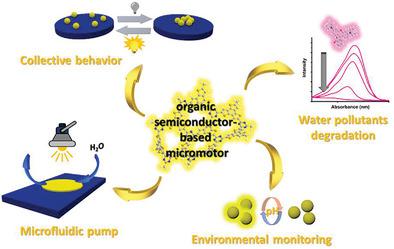当前位置:
X-MOL 学术
›
Adv. Funct. Mater.
›
论文详情
Our official English website, www.x-mol.net, welcomes your
feedback! (Note: you will need to create a separate account there.)
Multifunctional Visible‐Light Powered Micromotors Based on Semiconducting Sulfur‐ and Nitrogen‐Containing Donor–Acceptor Polymer
Advanced Functional Materials ( IF 18.5 ) Pub Date : 2020-07-23 , DOI: 10.1002/adfm.202002701 Yaroslav S. Kochergin, Katherine Villa, Filip Novotný, Jan Plutnar, Michael J. Bojdys, Martin Pumera
Advanced Functional Materials ( IF 18.5 ) Pub Date : 2020-07-23 , DOI: 10.1002/adfm.202002701 Yaroslav S. Kochergin, Katherine Villa, Filip Novotný, Jan Plutnar, Michael J. Bojdys, Martin Pumera

|
Photosensitive micromotors that can be remotely controlled by visible light irradiation demonstrate great potential in biomedical and environmental applications. To date, a vast number of light‐driven micromotors are mainly composed from costly heavy and precious metal‐containing multicomponent systems, that limit the modularity of chemical and physical properties of these materials. Herein, a highly efficient photocatalytic micromotors based exclusively on a purely organic polymer framework—semiconducting sulfur‐ and nitrogen‐containing donor–acceptor polymer, is presented. Thanks to precisely tuned molecular architecture, this material has the ability to absorb visible light due to a conveniently situated energy gap. In addition, the donor‐acceptor dyads within the polymer backbone ensure efficient photoexcited charge separation. Hence, these polymer‐based micromotors can move in aqueous solutions under visible light illumination via a self‐diffusiophoresis mechanism. Moreover, these micromachines can degrade toxic organic pollutants and respond to an increase in acidity of aqueous environments by instantaneous colour change. The combination of autonomous motility and intrinsic fluorescence enables these organic micromotors to be used as colorimetric and optical sensors for monitoring of the environmental aqueous acidity. The current findings open new pathways toward the design of organic polymer‐based micromotors with tuneable band gap architecture for fabrication of self‐propelled microsensors for environmental control and remediation applications.
中文翻译:

基于半导体含硫和氮供体-受体聚合物的多功能可见光微型电动机
可以通过可见光辐射远程控制的光敏微电机在生物医学和环境应用中显示出巨大的潜力。迄今为止,大量的光驱动微电机主要由昂贵的含重金属和贵金属的多组分系统组成,这限制了这些材料的化学和物理特性的模块化。本文介绍了一种高效的光催化微电机,该电机完全基于纯有机聚合物框架-半导体含硫和氮的供体-受体聚合物。得益于精确调整的分子结构,由于能隙位置便利,该材料具有吸收可见光的能力。此外,聚合物主链中的供体-受体二元体可确保有效的光激发电荷分离。因此,这些基于聚合物的微电机可以通过自扩散电泳机制在可见光照射下在水溶液中移动。而且,这些微型机器可以降解有毒的有机污染物,并通过瞬时颜色变化来响应水性环境的酸性增加。自主运动性和固有荧光的结合使这些有机微马达可用作比色法和光学传感器,以监测环境含水酸度。当前的发现为设计具有可调节带隙结构的有机聚合物基微电机开辟了新途径,以制造用于环境控制和修复应用的自推式微传感器。而且,这些微型机器可以降解有毒的有机污染物,并通过瞬时颜色变化来响应水性环境的酸性增加。自主运动性和固有荧光的结合使这些有机微型马达可用作比色法和光学传感器,以监测环境含水酸度。当前的发现为设计具有可调节带隙结构的有机聚合物基微电机开辟了新途径,以制造用于环境控制和修复应用的自推式微传感器。而且,这些微型机器可以降解有毒的有机污染物,并通过瞬时颜色变化来响应水性环境的酸性增加。自主运动性和固有荧光的结合使这些有机微型马达可用作比色法和光学传感器,以监测环境含水酸度。当前的发现为设计具有可调节带隙结构的有机聚合物基微电机开辟了新途径,以制造用于环境控制和修复应用的自推式微传感器。自主运动性和固有荧光的结合使这些有机微马达可用作比色法和光学传感器,以监测环境含水酸度。当前的发现为设计具有可调节带隙结构的有机聚合物基微电机开辟了新途径,以制造用于环境控制和修复应用的自推式微传感器。自主运动性和固有荧光的结合使这些有机微马达可用作比色法和光学传感器,以监测环境含水酸度。当前的发现为设计具有可调节带隙结构的有机聚合物基微电机开辟了新途径,以制造用于环境控制和修复应用的自推式微传感器。
更新日期:2020-09-18
中文翻译:

基于半导体含硫和氮供体-受体聚合物的多功能可见光微型电动机
可以通过可见光辐射远程控制的光敏微电机在生物医学和环境应用中显示出巨大的潜力。迄今为止,大量的光驱动微电机主要由昂贵的含重金属和贵金属的多组分系统组成,这限制了这些材料的化学和物理特性的模块化。本文介绍了一种高效的光催化微电机,该电机完全基于纯有机聚合物框架-半导体含硫和氮的供体-受体聚合物。得益于精确调整的分子结构,由于能隙位置便利,该材料具有吸收可见光的能力。此外,聚合物主链中的供体-受体二元体可确保有效的光激发电荷分离。因此,这些基于聚合物的微电机可以通过自扩散电泳机制在可见光照射下在水溶液中移动。而且,这些微型机器可以降解有毒的有机污染物,并通过瞬时颜色变化来响应水性环境的酸性增加。自主运动性和固有荧光的结合使这些有机微马达可用作比色法和光学传感器,以监测环境含水酸度。当前的发现为设计具有可调节带隙结构的有机聚合物基微电机开辟了新途径,以制造用于环境控制和修复应用的自推式微传感器。而且,这些微型机器可以降解有毒的有机污染物,并通过瞬时颜色变化来响应水性环境的酸性增加。自主运动性和固有荧光的结合使这些有机微型马达可用作比色法和光学传感器,以监测环境含水酸度。当前的发现为设计具有可调节带隙结构的有机聚合物基微电机开辟了新途径,以制造用于环境控制和修复应用的自推式微传感器。而且,这些微型机器可以降解有毒的有机污染物,并通过瞬时颜色变化来响应水性环境的酸性增加。自主运动性和固有荧光的结合使这些有机微型马达可用作比色法和光学传感器,以监测环境含水酸度。当前的发现为设计具有可调节带隙结构的有机聚合物基微电机开辟了新途径,以制造用于环境控制和修复应用的自推式微传感器。自主运动性和固有荧光的结合使这些有机微马达可用作比色法和光学传感器,以监测环境含水酸度。当前的发现为设计具有可调节带隙结构的有机聚合物基微电机开辟了新途径,以制造用于环境控制和修复应用的自推式微传感器。自主运动性和固有荧光的结合使这些有机微马达可用作比色法和光学传感器,以监测环境含水酸度。当前的发现为设计具有可调节带隙结构的有机聚合物基微电机开辟了新途径,以制造用于环境控制和修复应用的自推式微传感器。











































 京公网安备 11010802027423号
京公网安备 11010802027423号